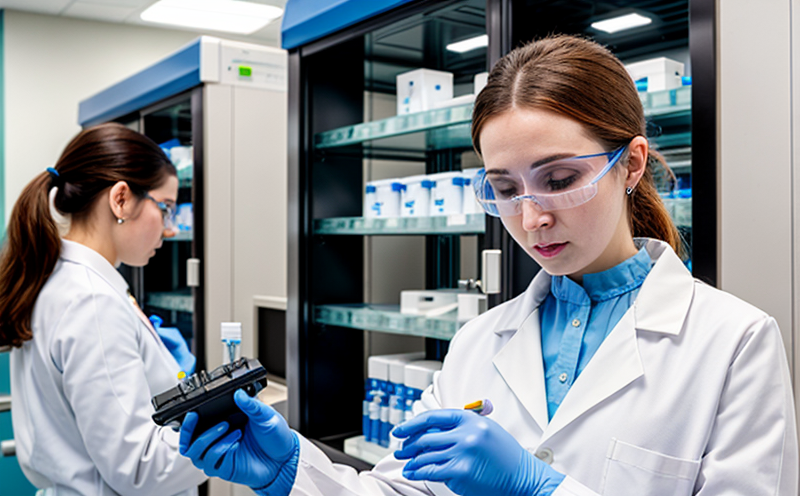SPR Surface Plasmon Resonance Binding Testing
The SPR (Surface Plasmon Resonance) Surface Plasmon Resonance Binding Testing method is a cornerstone of bioanalytical testing, especially in the pharmaceutical sector. It provides unparalleled sensitivity and specificity for measuring biomolecular interactions, making it indispensable for drug development and quality assurance.
This technique leverages surface plasmons—electromagnetic waves that occur at the interface between conductive materials and dielectric media—to detect mass changes on a sensor chip. The test involves immobilizing one component of the interaction (often an antibody or ligand) onto the sensor chip, then exposing it to various analytes in solution. Any binding event results in a change in refractive index near the sensor surface, which is detected by the SPR signal.
The primary application of this method lies in quantifying the binding affinity and specificity between biomolecules such as proteins, peptides, or small molecules. This capability ensures that potential drug candidates interact with their targets in the desired manner without unwanted side effects. It also aids in optimizing dosages and identifying active components within formulations.
The precision offered by SPR makes it particularly valuable for early-stage research where even minor interactions can have significant implications. For instance, pharmaceutical companies use this technology to screen large libraries of compounds efficiently, narrowing down candidates for further development based on their interaction profiles with known targets like receptors or enzymes.
Moreover, the real-time nature of the test allows for continuous monitoring during binding events, providing insights into kinetic parameters such as association and dissociation rates. These kinetic data are crucial for understanding how long a drug candidate remains bound to its target under physiological conditions—a critical factor in determining clinical efficacy.
In summary, SPR testing plays an integral role in ensuring that pharmaceutical products meet stringent regulatory standards regarding purity, potency, and safety. By leveraging this advanced technology early in the development process, organizations can enhance their chances of bringing effective treatments to market while minimizing risks associated with suboptimal formulations or ineffective drug candidates.
Scope and Methodology
| Component | Description |
|---|---|
| Biomolecular Interaction | The test involves immobilizing one component of the interaction (e.g., an antibody) on a sensor chip and exposing it to various analytes in solution. |
| Refraction Change Detection | Any binding event results in a change in refractive index near the sensor surface, detected by the SPR signal. |
| Data Analysis | Kinetic parameters like association and dissociation rates are calculated to assess interaction strength and specificity. |
Why It Matters
The importance of accurate bioanalytical testing cannot be overstated, especially within the pharmaceutical industry where even slight deviations can lead to significant discrepancies in drug efficacy and safety. SPR provides a robust solution by offering high-resolution detection capabilities that surpass traditional analytical methods.
In terms of regulatory compliance, adherence to stringent standards such as ISO 17025 ensures that laboratories delivering these tests maintain consistent quality and reliability. Additionally, the ability to monitor binding events in real-time allows researchers to make informed decisions promptly, streamlining the drug discovery process.
From an economic perspective, reducing false positives and negatives during early-stage screening saves substantial resources by focusing efforts on promising leads rather than pursuing dead-end candidates. Furthermore, ensuring that final products meet exacting standards helps protect brand reputation and consumer trust.
In conclusion, integrating SPR into the bioanalytical testing workflow enhances overall efficiency while maintaining high levels of accuracy and precision. This translates directly into improved product quality and increased success rates in clinical trials—a win-win situation for both manufacturers and patients alike.
Quality and Reliability Assurance
- Calibration: Regular calibration of the SPR instrument using certified reference materials ensures consistent performance over time.
- Data Validation: Independent validation of test results through replicate measurements or alternative methods enhances confidence in findings.
- Traceability: All testing protocols are traceable to international standards like ISO 17025, ensuring alignment with global best practices.
- Training and Certification: Personnel involved in conducting SPR tests undergo rigorous training and certification programs to ensure they possess the necessary skills and knowledge.
The combination of these measures guarantees that every SPR test conducted adheres to highest quality standards, thereby maintaining trustworthiness across all stages of pharmaceutical development.





